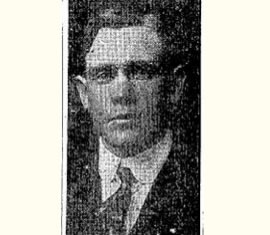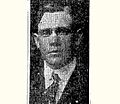Jesse Ray Ward facts for kids
Quick facts for kids
Jesse Ray Ward
|
|
|---|---|
 |
|
| Born | September 4, 1885 Republic, Kansas, U.S.
|
| Died | April 15, 1928 (aged 42) Salt Lake County, Utah, U.S. |
| Other names | J. Ray |
| Police career | |
| Department | |
| Years of service | 1921–1928 |
| Rank | Captain 145th Artillery, 1917 |
| Other work | Regimental Adjutant. |
Jesse Ray "J. Ray" Ward (born September 4, 1885 – died April 15, 1928) was an important U.S. Marshal. He served during the last years of the Old West period. President Harding chose him for this role.
J. Ray Ward lived in southern Utah. He was a member of the Immanuel Baptist Church. He also played a part in a historical event called the Posey War in 1923.
Contents
Early Life in the American Frontier
Jesse Ray Ward was born on September 4, 1885, in Warwick, Republic, Kansas. This area was part of the American frontier back then. As a young child, Jesse lived with his parents, John Ward and Francis Dancy. They lived in a dugout home on a homestead.
Their home was about 23 miles south of the Pine Ridge Reservation. This was during the time of the Ghost Dance War. Jesse's older sister, Bertha, wrote in her family story that they once saw smoke on the horizon. This was in the winter of 1890-1891.
About 30 miles north of their home, many Sioux people were killed. This event is known as the Wounded Knee Massacre. The smoke the Ward children saw might have been from these events. A year later, Jesse's father, John Ward, died from typhoid. His mother, Francis Dancy Ward, then took the children back to Republic, Kansas, to live with her parents.
Career as a Public Servant
Jesse Ray Ward went to school and later worked for the railroad. He married Henrietta Gebhart on Christmas Day in 1908. Their wedding was a Baptist ceremony.
J.R. Ward served in the United States Army in the 145th Field Artillery. He was in Bordeaux, France during the end of World War I. He was promoted to Regimental Adjutant, which is a high-ranking officer.
In 1921, he became the Marshal of Utah. Before this, he was the commissioner of public safety in Ogden.
The Posey War of 1923
In February 1923, two young Ute boys robbed a ranch in Utah. They later gave themselves up to the local sheriff in Blanding. But on March 20, the first day of their trial, something happened that led to the "Posey War." This was the last Indian uprising in American history.
The Ute boys ran away from Blanding. Their chief, an old man named Posey, helped them. He led his people to Comb Ridge. During the fighting that followed, Posey was hurt. His group was captured by a posse, which is a group of citizens helping the law.
Chief Posey managed to escape, but he died a few days later from his injuries. Marshal Ward was the person Governor Charles Mabey sent to identify Posey's body. Ward buried the chief's body and tried to hide the grave. However, local settlers dug up Posey's body at least twice to take pictures with it.
Death and Legacy
Marshal Ward died on April 15, 1928, when he was 42 years old. He was driving his automobile from Bingham to West Jordan. He crashed his car at a turn in the road. His vehicle left the road, hit a utility pole, and flipped over.
Ward died right away from injuries to his head and chest. His funeral was held at the Immanuel Baptist Church. He had been a member of this church since he was 14. His family was very dedicated to the church, and all four of his children grew up there.
Jesse Ray Ward left behind his wife and four children. He is buried at Mount Olivet Cemetery. Later, a bronze plaque was made in his memory. This plaque was sponsored by Ellis and Katie Ivory.
Images for kids


